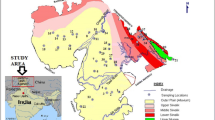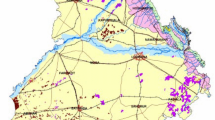Abstract
The present investigation focused on evaluation of uranium containing water quality and non-carcinogenic risk. The uranium was determined in the fifty-three groundwater samples ranged between 0.21 and 10.04 µg/L. The 30% of groundwater samples surpass the recommended limits (1.9 μg/L) and the chronic daily intake also exceeded recommended reference dose (0.6 µg/kg/day) in 6–6% samples for Infant and Children while it was found 8% for adults. Uranium has showing a positive correlation with TDS, electrical conductivity, chloride, Total hardness, calcium, magnesium, and total alkalinity. This investigation creates awareness among the people about purity and quality of groundwater.





Similar content being viewed by others
References
Banks DO, Røyset TS, Skarphagen H (1995) Radioelement (U, Th, Rn) concentrations in Norwegian bedrock groundwaters. Environ Geol 25:165–180
Nolan J, Weber KA (2015) Natural uranium contamination in major US aquifers linked to nitrate. Environ Sci Technol Lett. 2:215–220
WHO (2004) “Guidelines for Drinking Water Quality” Radiological aspects, Geneva 1-494
AERB (2004) Drinking water specifications in India. Department of Atomic Energy Govt. of India
Berlin M, Rudell B (1986) Handbook on the toxicology of metals, vol II: specific metals. Elsevier, Amsterdam
ATSDR, Agency for toxic Substances and Diseases Registry (1999) Toxicological profile. Atlanta, US, department of health and human services Public health services
Limson Zamora M, Tracy BL, Zielinski JM, Meyerhof DP, Moss MA (1998) Chronic ingestion of uranium in drinking water: a study of kidney bio effects in humans. Toxicol Sci 43:68–77
Kurttio P, Komulainen H, Leino A, Salonen L, Auvinen A, Saha H (2005) Bone as a possible target of chemical toxicity of natural uranium in drinking water. Environ Health Perspect 113:68–72
Babu MN, Sridhar RK, Somashekar SA, Kumar K, Shivanna VK, Eappen KP (2008) Concentration of uranium levels in groundwater. Int J Environ Sci Technol 5:263–266
Kansal S, Mehra R, Singh NP (2011) Uranium concentration in ground water samples belonging to some areas of western, Hariyana, India using fission tracks registration technique. J Public Health Epidemiol 3:352–357
Cothern CR, Lappenbusch WL (1983) Occurrence of uranium in drinking water in the US. Health Phys 45:89–99
Tanner AB (1980) Radon migration in the ground: a supplementary review in: the natural radiation environment III. In: Gesell TF, Lowder WM (eds) National Technical Information Services, Springfield, VA. CONF-780422, 1: 5–56
Bariki SK, Saramanda G (2013) Drinking water quality by water quality index method in pre and post monsoon in Araku Valley Region, Visakhapatnam District, Andhra Pradesh, India. Int J Sci Res. https://doi.org/10.21275/art201666
Hameed A, Obaidy AMJ, Haider A, Maulood BK (2010) Application of water quality index for assessment of Dokan lake ecosystem, Kurdistan region, Iraq. J Water Resour Protect 2:792–798
World Health Organization (2010) Hardness in drinking-water: background document for development of WHO guidelines for drinking-water quality. No. WHO/HSE/WSH/10.01/10
Singh RP, Mathur P (2005) Investigation of variations in physico-chemical characteristics of a fresh water reservoir of Ajmer city, Rajasthan. Indian J Environ Sci 9:57–61
Salem JK, Draz MA (2020) Selective colorimetric nano-sensing solution for the determination of phosphate ion in drinking water samples. Int J Environ Anal Chem. https://doi.org/10.1080/03067319.2019.1702168
Rahman MA, Hashem MA (2019) Arsenic, iron and chloride in drinking water at primary school, Satkhira, Bangladesh. Phys Chem Earth Parts A/B/C 109:49–58
UNSCEAR (2008) Report to the general assembly. Annex B, New York
Bomben AM, Equillor HE, Oliveira AA (1996) 226Ra and natural uranium in Argentinian bottled mineral waters. Radiat Prot Dosim 67:221–224
Rossiter HMA, Owusu PA, Awuah E, MacDonald AM, Schäfer AI (2010) Chemical drinking water quality in Ghana: water costs and scope for advanced treatment. Sci Total Environ 408:2378–2386
Kumru MN (1995) Distribution of radionuclides in sediments and soils along the Buyuk Menderes River. Proc Pak Acad Sci 32:51–56
Amakom CM, Jibiri NN (2010) Chemical and radiological risk assessment of uranium in borehole and well waters in the Odeda Area, Ogun State, Nigeria. Int J Phys Sci 5:1009–1014
Gedeon R, Smith B, Amro Jawadeh J (1994) Natural radioisotopes in groundwater from the Amman-Zarka basin Jordan. Hydrochemical and regulatory implications. Applications of Tracers in Arid Zone Hydrology, Wallingford
Jurgens BC, Fram MS, Belitz K, Burow KR, Landon MK (2010) Effects of Groundwater development on uranium-Central Valley, California, USA. Groundwater 48:913–928
Lee MH, Choi GS, Cho YH, Lee CW, Shin HS (2001) Concentrations and activity ratios of uranium isotopes in the groundwater of the Okchun Belt in Korea. J Environ Radioact 57:105–116
Brown AA, Steenfelt A, Kunzendorf H (1983) Uranium districts defined by reconnaissance geochemistry in South Greenland. J Geochem Explor 19:127–145
Bhangare RC, Tiwari M, Ajmal PY, Sahu SK, Pandit GG (2013) Laser flourimetric analysis of uranium in water from Vishakhapatnam and estimation of health risk. Radiat Protect Environ 36:128
Rani A, Mehra R, Duggal V, Balaram V (2013) Analysis of uranium concentration in drinking water samples using ICPMS. Health Phys 104:251–255
Singh B, Garg VK, Yadav P, Kishore N, Pulhani V (2014) Uranium in groundwater from western Haryana, India. J Radioanal Nucl Chem 301:427–433
Ben BS, Sunil A, Reeba MJ, Christa EP, Vaidyan VK, Prasad R, Jojo PJ (2012) Uranium in drinking water from the south coast districts of Kerala, India, pp 31–36
Soma G, Jha VN (2012) Risk assessment (chemical and radiological) due to intake of uranium through the ingestion of drinking water around two proposed uranium mining areas, Jharkhan d, India. Radioprotection 47:543–551
Singh S, Malhotra R, Kumar J, Singh B, Singh L (2001) Uranium analysis of geological samples, water and plants from Kullu Area, Himachal Pradesh, India. Radiat Meas 34:427–431
Nagaiah N, Mathews G, Balakrishna KK, Rajanna AM, Naregundi K (2013) Influence of physico-chemical parameters on the distribution of uranium in the ground water of Bangalore, India. Radiat Protect Environ 36:175–180
Sethy NK, Tripathi RM, Jha VN, Sahoo SK, Shukla AK, Puranik VD (2011) Assessment of natural uranium in the ground water around Jaduguda uranium mining complex, India. J Environ Protect 2:1002
APHA (2005) Standard methods for the examination of water and wastewater, Washington, DC
Sahu P, Kisku GC, Singh PK, Kumar V, Kumar P, Shukla N (2018) Multivariate statistical interpretation on seasonal variations of fluoride-contaminated groundwater quality of Lalganj Tehsil, Raebareli District (UP), India. Environ Earth Sci 77:484
World Health Organization (2011) Guidelines for drinking water quality recommendations, Geneva, 4th edition 1: 515
Sharma S, Chhipa RC (2012) Evaluation and Optimization of Water Quality Index for ground water source of North West Jaipur and Agglomerates. Int J Chem Sci 10:2297–2305
Sahu M, Sar SK, Dewangan R, Baghel T (2019) Health risk evaluation of uranium in groundwater of Bemetara district of Chhattisgarh state, India. Environ Dev Sustain 1–20
ICRP-30 (1979) Limits for intake of radionuclides by workers. Pergamon Press, Oxford
Kale A, Bandela N, Kulkarni J (2020) Assessment of chemo-radiological risk of naturally occurred uranium in groundwater from the Beed district, India. J Radioanal Nucl Chem 323:151–157
Sar SK, Diwan V, Biswas S, Singh S, Sahu M, Jindal MK, Arora (2018) A Study of uranium level in groundwater of Balod district of Chhattisgarh state, India and assessment of health risk. Human and Ecological Risk Assessment. Int J 24:691–698
Sar SK, Sahu M, Singh S, Diwan V, Jindal MK, Arora A (2017) Assessment of uranium in ground water from Durg District of Chhattisgarh state and its correlation with other quality parameters. J Radioan Nucl Chem 314:2339–2348
Keith S, Faroon O, Roney N, Scinicariello F, Wilbur S, Ingerman L, Llados F, Plewak D, Wohlers D, Diamond G (2013) Toxicological Profile for Uranium, Atlanta (GA): agency for toxic substances and disease registry (US)
Kumar A, Rout S, Narayanan U, Manish KM, Tripathi RM, Singh J, Kumar S, Kushwaha HS (2011) Geochemical modelling of uranium speciation in the subsurface aquatic environment of Punjab State in India. J Geol Min Res 3:137–146
Sharma P, Meher PK, Mishra KP (2012) Distribution of non-radioactive heavy elements in water of river Ganges form Rishikesh to Allahabad: a study on possible health effects. J Nehru Gram Bharati Univ 1:52–58
USEPA (1989) IRIS (Integrated Risk Information System). Office of Health and Environmental Assessment, Washington, DC, USA
Acknowledgements
The authors would like to express deepest thanks and gratitude to the National Institute of Technology, Raipur for the support and providing laboratory facilities to conduct this experiment.
Author information
Authors and Affiliations
Corresponding author
Ethics declarations
Conflict of interest
The author’s declare that there is no conflict of interest between them.
Additional information
Publisher's Note
Springer Nature remains neutral with regard to jurisdictional claims in published maps and institutional affiliations.
Rights and permissions
About this article
Cite this article
Singh, M., Tapadia, K., Jhariya, D. et al. Evaluation of uranium containing ground water quality and non-carcinogenic risk assessment in inhabitant of Bijapur District of Chhattisgarh, Central India. J Radioanal Nucl Chem 327, 939–947 (2021). https://doi.org/10.1007/s10967-020-07572-0
Received:
Accepted:
Published:
Issue Date:
DOI: https://doi.org/10.1007/s10967-020-07572-0




